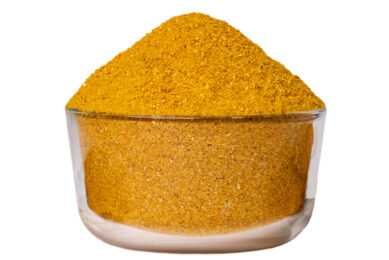Effect of phytase in pig diets with corn co-products

Because phosphorus in distillers dried grains co-products is well digested by pigs even if no microbial phytase is used, the addition of phytase leads to relatively little increase in phosphorus digestibility in these ingredients, and thus is not economical.
By Ferdinando Almeida, graduate student and Hans Stein, professor at University of Illinois, USA
Helping pigs digest more of the phosphorus that naturally occurs in the diet could provide a costeffective alternative to inorganic phosphorus supplementation while also helping to reduce the environmental burden of excreted phosphorus. An experiment was conducted to determine how adding graded levels of microbial phytase affected the standardized total tract digestibility (STTD) of phosphorus in corn and corn coproducts. From these data, regression equations were developed to predict the response to adding different levels of phytase to each ingredient.
Diets based on corn, distillers dried grains with solubles (DDGS), high protein distillers dried grains (HP-DDG), and corn germ were formulated. To each of these experimental diets was added microbial phytase to supply a total in the diet of 0, 500, 1,000, or 1,500 phytase units (FTU) per kg. In addition to these 16 diets, a phosphorus- free diet was used to measure the basal endogenous phosphorus loss (EPL) from the pigs. A total of 102 growing pigs were allotted to the 17 diets in a randomised complete block design with 6 replicate pigs per diet. For the purposes of this experiment, analysed values for phytase activity were used in all calculations instead of calculated values.
The amount of phosphorus, which is bound to phytate is significant in determining how the addition of microbial phytase will affect phosphorus digestibility. Those ingredients with a relatively high ratio of phytate-bound phosphorus to total phosphorus are expected to show the greatest increase in phosphorus digestibility with the addition of microbial phytase (Table 1).
Digestibility of phosphorus
The analysed levels of phytase in corn diets were < 70, 420, 720, and 1,100 FTU/kg. Both apparent and standardised total tract digestibility of phosphorus increased linearly and quadratically as phytase was added to the diets (Table 2). Addition of graded levels of phytase also decreased the concentration of phosphorus in the faeces and phosphorus output in grams per day. The quadratic response for the STTD of phosphorus in corn to the addition of increasing levels of phytase is described by the following equation:
STTD of P, % = 42.34 + 0.059 FTU – 0.000028 FTU2 (R2 = 0.63)
The analysed levels of phytase in the diets containing DDGS were 130, 430, 770, and 1,100 FTU/kg. Addition of phytase to the diets tended to increase the apparent and standardised total tract digestibility of phosphorus (Table 2). This indicates that the value for STTD of phosphorus determined for DDGS without phytase may also be used if phytase is added to the diet at any inclusion level. Addition of graded levels of phytase, however, reduced the concentration of phosphorus in faeces, but did not decrease phosphorus output in grams per day. No regression equation was developed for the response of STTD of phosphorus in DDGS because no significant response was observed.
The analysed levels of phytase in the diets that contained HP-DDG were < 70, 500, 770, and 1,100 FTU/kg. Addition of phytase to the diets increased both apparent and standardised total tract digestibility of phosphorus up to an analysed level of 500 FTU/kg. There was no increase in digestibility with the addition of greater concentrations of phytase. Addition of graded levels of phytase decreased the concentration of phosphorus in the faeces and phosphorus output in grams per day.
The quadratic response for the STTD of phosphorus in high protein distillers dried grains to the addition of increasing levels of phytase is described by the following equation:
STTD of P, % = 77.55 + 0.023 FTU – 0.000014 FTU2 (R2 = 0.36).
Although the equation was significant, the R2 value was only 0.36, which indicates that this equation explained only 36% of the variability in the STTD of P. The developed equation, therefore, has limited practical applications.
The analysed levels of phytase in corn germ-containing diets were 110, 390, 910, and 1,400 FTU/kg. The addition of phytase to the diets increased both apparent and standardised total tract digestibility of phosphorus (Table 2) up to an analysed level of 910 FTU/kg. Addition of graded levels of phytase also decreased the concentration of phosphorus in faeces and phosphorus output in grams per day.
The quadratic response for the STTD of phosphorus in corn germ to the addition of increasing levels of phytase is described by the following equation:
STTD of P, % = 34.50 + 0.067 FTU – 0.000034 FTU2 (R2 = 0.79)
Conclusions
The current work indicates that addition of phytase to diets based on corn or corn germ greatly increases the STTD of P. The actual STTD of P at any level of phytase between 0 and 1100 FTU can be calculated using the prediction equations that were developed.
Both DDGS and HP-DDG contain much less phytate bound phosphorus relative to total phosphorus than corn and corn germ: 31% and 28%, respectively, for DDGS and HP-DDG, versus 72% and 76%, respectively, for corn and corn germ. This is probably because the fermentation process that produces them hydrolyzes phytate and liberates phosphorus. Because these ingredients have less phytate bound phosphorus, the addition of microbial phytase has less of an effect on phosphorus digestibility in DDGS and HPDDG than in corn and corn germ.
Key points
- Standardised total tract digestibility of phosphorus in DDGS and HP-DDG is much greater than in corn and corn germ when phytase is not added. This is probably due to the fact that phytate bound phosphorus makes up a much greater percentage of total phosphorus in corn and corn germ. The two distillers dried grains co-products in this study have similar values for both phytate bound phosphorus and phosphorus digestibility.
- Because phosphorus in distillers dried grains co-products is well digested by pigs even if no microbial phytase is used, the addition of phytase leads to relatively little increase in phosphorus digestibility in these ingredients, and thus is not economical.
- The addition of microbial phytase to the diet increases the digestibility of phosphorus in corn and corn germ, and this response can be predicted by regression equations. Pigs fed corn or corn germ may not need a maximum release of phosphorus from these ingredients to meet their requirement for phosphorus. In that case, a reduced concentration of phytase may be used, and the regression equations developed in this experiment can help determine the amount of phytase to use to maximize economic efficiency.
[Source: Enzyme special]











